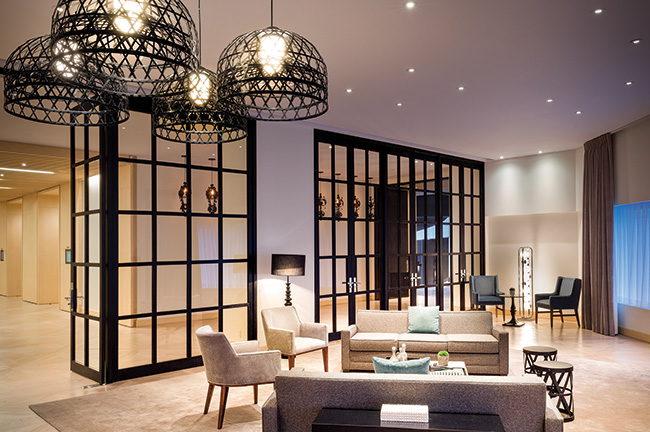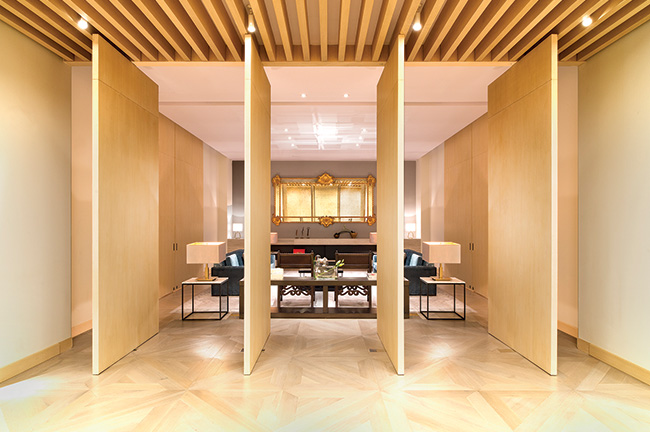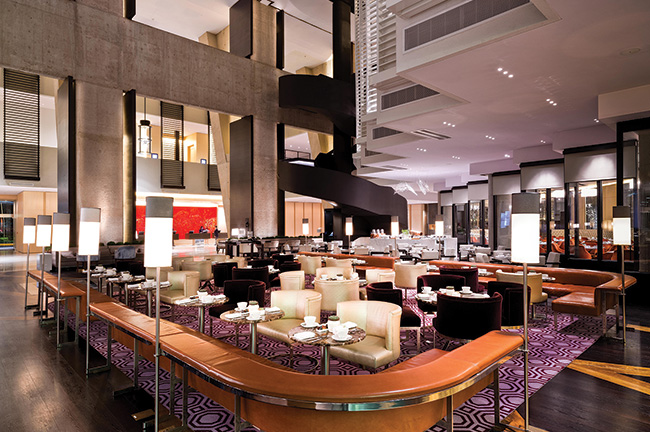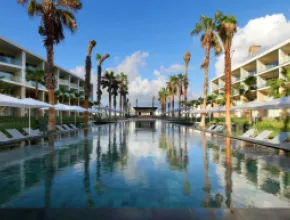As someone who has covered the hospitality industry for nearly 30 years, visiting every conceivable hotel grade and concept on every continent save for Antarctica, the design critique I have as soon as I open a guest room door is as simple as it is relevant.
Does everything work?
It may seem exceedingly elementary, but minimizing frustration is job No. 1 for hotels, in my opinion.
After traveling for hours—and sometimes days—to plop yourself down in a comfortably appointed room, do you really want to hunt around to discover where to charge your devices?
Do you need an engineering degree to figure out how to set the room temperature? Is there a surface to work on without having to prop yourself up with pillows on the bed?
(Even though that’s where I usually end up, anyway).
Turns out I have a kindred spirit at the highest echelon of the hotel design community in George Wong, the head of George Wong Design, who for more than 30 years has led inspired projects at top hotels across the globe.
“Every time you take something for granted in your home-base area, and then you go into a hotel and you have to look around to plug something in, it’s such a hassle—it should be so intuitive,” Wong said with an enthusiastic tone, perhaps joyed that another soul in this overdesigned world shared his respect of the simple things in life. “As a business traveler you want to be focused on what you’re doing, and traveling is always frustrating. I think the hospitality industry should aim to make it seamless for the business traveler.
"Plugging in and charging should be intuitive and in plain sight," he added. "Nowadays charging and powering via a USB [outlet] is a basic requirement, whether in a lounge, restaurant or cafe—everywhere."
Eventually, wireless charging pads will become an expected amenity, Wong said, built into tables like an induction cooktop. If not in the next couple of years, in the near future.
He also expects all hotels to be on a common platform for room controls, from check-in to check-out, so you don’t need separate Marriott or Hyatt apps to control the lights, for instance.
“I think it’s just a matter of time until there is a universal platform,” he predicted.
An Impressive Hotel Design Resume
Utilitarian and universalist tastes aside, Wong’s name was and is attached to the design of some of the most acclaimed hotels and resorts in the world.
Resume pieces include directing the design of Moscow’s Grand Hyatt Hotel as the New York lead for the celebrated design firm Yabu Pushelberg; The St. Regis Hotel at Bal Harbour; New York’s Dos Caminos Restaurant; and Shangri-La Hotels & Resorts’ Far Eastern Plaza Hotel in Taipei.

New Meeting Zones 01, Hyatt Regency Mexico City
Wong, in fact, designed my favorite hotel in the world, the Four Seasons Bali at Jimbaran Bay, with its cascading, bougainvillea-festooned bungalows with private plunge pools overlooking the Indian Ocean.
“There were very successful Aman Resorts there—Amanusa, Amandari, etc.,” Wong said. “The founder was an ex-partner of Regent Hotels, and they thought they would do a larger scale of what Aman had done. They saw an opportunity to capitalize on a small boutique resort but on a larger scale.
“It’s almost a copy of Amandari, with 125 bungalows,” he added. “You enter at the highest point and see the thatched rooftops and the bay because it’s built on a very steep slope. It opened in 1992 and was immediately one of the top-10 best resort destinations in the world. It’s still one of a kind.”
Hyatt Hotels & Resorts takes up the bulk of his most current projects, including the Hyatt Times Square New York; Hyatt Regency Mexico City; Hyatt Regency Paris Etoile; Park Hyatt Chennai (India); The LakeHouse, restaurant in Orlando’s Hyatt Grand Cypress; Grand Hyatt New York; Hyatt Regency Trinidad; Grand Hyatt Sao Paolo; and Hyatt Regency Hongqiao, Shanghai.
He also recently designed the New York City flagship restaurant of Da Dong Restaurant.
Originally from Hong Kong, the New York-based Wong is currently mainly ensconced in hotel projects in the Asia-Pacific region, along with two hotels in Paris and Mexico City, hotels in Scottsdale, Arizona, and Orlando, and one in Nairobi, Kenya.
Good Hotel Design Includes Meeting Space Design
According to Wong, meeting space always figures prominently in his design.
His largest current project, the Hyatt Regency Paris Etoile, is attached to the largest convention center in Europe, the Paris Convention Centre.
Alleviating registration bottlenecks was a prime directive in the redesign of the former Hotel Concorde La Fayette, a nearly 1,000-room hotel attached to a convention center that can accommodate 35,000 attendees.
“In a matter of a couple days people come in and go out so you have to handle thousands of registrations,” Wong said. “It has a huge lobby that serves as the registration area for the Congress, and it had problems with conflicts with guests checking in with hotel.”
[Related Content: 4 Simple Wayfinding Techniques to Help Guide Attendees]
To solve the dilemma, Wong installed caddies with LED screens that could register attendees and provide information about the location of meetings and events, but this solution required the kiosks to be plugged into power outlets, which created a tripping hazard.
Technology ultimately improved to provide a solution.
“Even last year we were even still talking about ‘forget about the outlets, let’s go with batteries.’ But we still could not mitigate the problem of congestion in the lobby,” he said. “Now it’s all smartphone check-in and the scanner would scan you like you would board a plane—so no printing of badges.
“So, it solved a problem,” Wong continued. “The congestion is down by two-thirds.”

New Meeting Zones 02, Hyatt Regency Mexico City
Lessening registration congestion is a design problem suffered on a worldwide scale, it seems.
“A lot of the hotels with huge convention facilities always have makeshift registration areas, so the hotel doesn’t even look like a hotel. It downgrades it,” Wong said. “For renovations, the first thing they ask us to do is eliminate the temporary registration desk and have satellite check-in centers.
“Each floor has a registration center for that floor,” he explained.
“By doing so we manage to relocate all of the congestion for event registration away from the lobby, so guests are entering into a classy space and not entering into a marketplace,” Wong added.
Millennials Drive Hotel and Meetings Design
Millennials are also making a big impact on meeting space design.
“A few years ago, we designed a Hyatt Regency in Cali, Colombia, with one floor of meeting space but no prefunction space,” Wong said. “We carved out maybe one-third of the floor space for a lounge area and a breakout space. It was like a meeting lounge, with a fireplace, coffee bar, pool table, a few private alcoves and chairs.”
This new concept of ad hoc meeting space can be turned into a revenue generator for hotels.
“Those areas can also be rented out as meeting spaces,” Wong said. “Not in a room, but maybe you have a corner, or eight people by a fireplace, or the library.
“It’s a revenue space doubling up as a breakout space,” he added. “If you’re a hotel guest and want to just work there, you just pay an extra fee from your room and you use the facilities.”
[Related Content: Benefits of Natural Light for Attendees]
Some forward-thinking hotels are taking a less-permanent view of their food and beverage outlets in order to rapidly transform them into revenue-generating shared workplace zones.

Redesigned Lobby Lounge and Bar Example
“An example is the Hyatt Regency Paris Etoile,” Wong said. “You have to feed 1,000 for breakfast but in the afternoon everyone is out so the space is empty. So, we take half of the all-day dining area and turn it into a casual work lounge; a shared work space when breakfast is removed. That’s a good way to utilize some F&B areas when it’s busy in the morning but kind of dead in the rest of the day.
“Whether old or new or Millennial, people are enjoying the benefit of being with people,” he added. “They like sharing the same space.”
Hotel Design Trends: Comfort Versus Opulence
While catering to the younger generations entering the business travel world is roundly considered an extremely smart strategy, hotels can also make mistakes by assuming too much about their preferences.
“Every hotel brand said they were doing without the desk, and for two years everyone requested the deck back—now there’s not a room without a desk,” Wong laughed. “When you stay in a hotel room you should feel at home. They should have a table at 30 inches high. When you get into a hotel without that, something is missing, so I think they over-boarded with the Millennials.”
Lobby spaces are where Millennial preferences really take hold, according to Wong.
“They like to be around people,” he said. “The big lobby days are gone. They should be cozier, smaller. You want a lot of people in the lobby and using it as a work space. The days of the grand hotel are coming to an end. All of these hotels should offer cozier stays, kind of back to human scale.”
Interestingly enough, Wong said the cozy feel is definitely not taking hold in the Asia-Pacific region.
“For Asian hotels that I work on, they’re still going for the grandeur of the hotel—the crystal chandelier—but it’s a different culture,” Wong said. “Their culture is about the perceived opulence of the space. Asian guests want the grandness, and to feel important.
“I think in the West people feel more important about how comfortable they feel,” Wong continued. “They like to have a more personal experience, so the scale of the grandness is not as important—the experience they feel and the interaction with people is more important.
“The West is leading the way with more personalized places instead of these grand, cold places.”
[Read This Next: How to Cope With a Convention Center Renovation]







